#dance in central america
Text

Another banger mr. Chen
#cia#central intelligence agency#chinatown#hws china#aph china#street dance of china#china#cia agent#ausgov#politas#auspol#tasgov#taspol#australia#fuck neoliberals#neoliberal capitalism#anthony albanese#albanese government#usa news#usa#american indian#american#america#amerika#amerikkka#joe biden#biden administration#president biden#biden#spying
12 notes
·
View notes
Photo
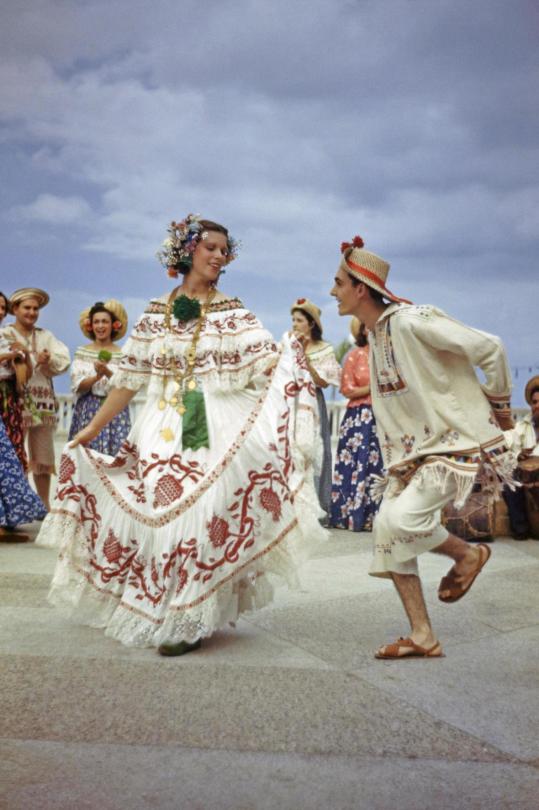
A couple dances the Tamborito, a Panamanian folk dance - Luis Marden
72 notes
·
View notes
Text
Join Portland Central America Solidarity Committee
If the topics on my blog about Latin American women political prisoners has inspired you, and you'd like to take an active part in the movement here in the United States, the best organization I can recommend for this is Portland Central America Solidarity Committee. They are focused on Central America but have also had campaigns about Colombia and the rest of South America. They raise awareness about past atrocities, but also women activists and political prisoners who today are suffering the kinds of abuses I document on my blog.
The Portland Central America Solidarity Committee, PCASC, was founded in 1979 by a group of activists concerned about US military and economic policy in Central America. In 1982, PCASC volunteers organized and successfully passed a county ballot measure calling on the federal government to end military support to the government of El Salvador, engaging and educating hundreds of thousands of voters.



An example of an interpretive dance performance event raising awareness about women political prisoners in Central America



A similar organization with chapters in many cities
1 note
·
View note
Text
World music festival showcases global talent in our backyard
WOMAD 2023 UPDATE
This article by Jennifer Little was first published in our FEB/MAR 2022 issue.
It’s a festival of surprises where you are spellbound by the eerie mystique of Mongolian throat singers one minute then captivated by the passion of a Portuguese Fado folk artist the next. Or find yourself in a joyfully frenzied crowd dancing to irresistible Cuban or Congolese Afro-fusion…
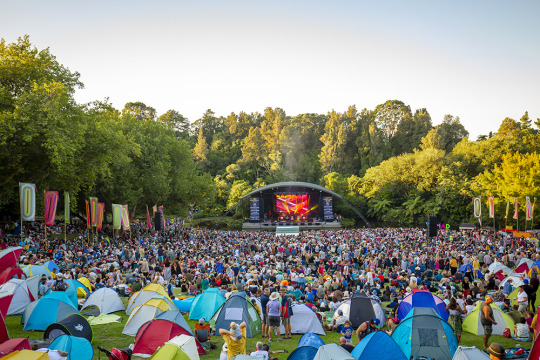
View On WordPress
#ACAPOLLiNATIONS#ADG7#Africa#Anna Fifield#Aotea Centre#arts#Asia#Auckland#Bab L&039;Bluz#Béla Fleck & Abigail Washburn#Bowl of Brooklands#Central America#Cimafunk#community#Constantinople#Culture#dance#Deva Mahal#Dick Frizzell MNZM#diversity#Dr Susette Goldsmith#Europe#families#Fantastic Negrito#festival#Fly My Pretties#Genesis#Hinke Osinga#Justin Adams & Mauro Durante#Kefaya &v Elaha Soroor
0 notes
Text
Panjabi MC - Mundian To Bach Ke
2002
"Mundian To Bach Ke", also titled "Beware of the Boys (Mundian To Bach Ke)" or "Beware", is a bhangra music song produced by British musician Panjabi MC, with vocals and lyrics by Punjabi artist Labh Janjua. The song was produced by Panjabi MC in Birmingham, England, for his 1998 album Legalised.
In addition to features of bhangra music, "Mundian To Bach Ke" also uses the bass line and part of the beat from "Fire It Up" (1997) by Busta Rhymes, which in turn is based around a sample from the television theme song for Knight Rider.
Following its release as a single in November 2002, "Mundian To Bach Ke" achieved worldwide success, topping the singles charts in Italy and Wallonia and charting highly in many other countries. A remix of the song, released in 2003 and featuring American rapper Jay-Z, also charted highly in North America and Australia. The song sold an estimated 10 million copies worldwide, making it one of the best-selling singles of all time.
"Mundian To Bach Ke" was released as a single in Germany on 25 November 2002. It sold over 100,000 in the first two days alone and debuted at number two on the German Singles Chart. On the Italian Singles Chart, the song reached number one for three weeks. In the UK, it was issued through Instant Karma and debuted at its peak of number five on the UK Singles Chart; it was the first bhangra song to reach the UK top 10.
It has been featured in many movies and tv shows as well as the dance games Dance Central 3 and Just Dance 4.
It received a total of 78% yes votes!
youtube
2K notes
·
View notes
Text




Ancient Maya painting in the Temple of the Murals, Bonampak, Mexico. Dating to around 790 CE.
This precisely and elegantly rendered scene depicts a ritual costumed dance.
A masked group of gods and aquatic animals reenact a myth with themes of fertility and transformation. Water lilies sprout from their headdresses and limbs. Two deities exchange an ear of maize, representing the act of creation and the seed of future rebirth. To the left, court musicians play large wooden trumpets to heighten the drama of the scene.
The moment of transfiguration from human to crocodile is suggested by the two sitting male figures, the first of which wears an elaborate, theriomorphic white headdress. He is also adorned with a bulbous jade necklace whose form is echoed in the scales of the crocodile mask to which he points.
To the right, a dancer representing a crayfish raises his arms in a dramatic gesture. The final figure, likely a deity, wears a skull-like mask and water-lily headdress with a fish. He holds a white tunkul , a wooden slit drum still played today in many areas of Central America.
292 notes
·
View notes
Note
Jimin had a solo era where he had 10 days of mostly local promo except for Jimmy Fallon for his 6 song EP (1 b-side + 1 title track) in Mar 2023 + 1 collab (with Kodak and Jvke) in the F&F movie franchise in May 2023 + 1 collab with Taeyang of Big Bang in Jan 2023 with accompanying mvs for both collabs + 1 fansong released on christmas week 2023 with 30 hours of notice and recycled footage for its mv + 1 documentary released on weverse in Oct 2023.
JK had a solo era where immediately after hiatus he released left & right in June 2022 with Charlie Puth who's pretty famous in his own right, a world cup song in Nov 2022 and performed solo in the opening ceremony which was watched by 1.5 billion viewers. He then proceeded to release Seven in July 2023 with latto who's also pretty damn famous in the west with Grammy winning producers and an accompanying mv with Han So Hee. Seven is perhaps the most payola'd kpop song of all time - I can't even list it all down without making this ask huge but suffice to say that with all the ads and playlisting on several platforms including tth from day 1 and some help from spotify to keep all his combined versions together instead of splitting them and probably a tiktok heating deal - seven managed to stay on top of global for weeks and netted a bunch of records.
However moving on, JK performs at good morning america, is supposed to perform at the mtv emas (gets cancelled) and announces his next single 3D with Jack Harlow at Global Citizen Fest at NY releasing in Sep 2023. He also has a collab too much with kid laroi and central cee in Oct 2023 with an accompanying mv. After that we're gearing up for his all English album release in Nov 2023 with a 11 track album. He has features from major lazer and dj snake and songs composed and produced by the likes of Diplo, Ed Sheeran and Shawn Mendes. He goes on to perform snty at Jimmy Fallon, Times Square and iHeartRadio live. While none of his songs post seven are as heavily payola'd, they're still very well promoted. In Dec 2023, he releases a remix of SNTY with usher with an accompanying mv. He also features in hots in single I wonder in March 2024. Finally he's released a fan song never let go for festa in June 2024 which is a fansong but has a bunch of benefits usually seen for digital singles but no MV.
Obviously I haven't mentioned everything like their ambassadorships, their single bad decisions with benny blanco (mostly because I forgot about it), smaller promo like suchwita, JK's radio interviews, his visualisers, Jimin's Korean shows, either of their mnet performances, their myriad of tiktoks, their dance performances on youtube, JK's week-long station head parties or accompanying Yoongi on the D-Day tour. Plus as I said I can't mention the full length and breadth of JK's promo compared to Jimin in smaller aspects like number of remixes / remix albums or cd stock because this'll go on forever. And of course this is only the status as of today. We know pjm2 is coming as is probably a documentary for JK and their travel show together. Though I've probably missed out some things for both, I think I've covered the main points of both the solo eras.
There's a bunch of stuff happening here. For one JK's solo era is spaced out very well regardless of who else among BTS is releasing. While other members are clustered in specific times to avoid overlap, JK manages to have the most well spaced out solo era sometimes to the detriment of a member whose promo he might be encroaching on (debatable but I think it's true). The world cup gig which undoubtedly went to BTS being co-opted as JK's solo has never sit right with me but whatever. People can delude themselves about how in demand JK is but the truth is Latto, Jack Harlow and others probably got very well paid for collabing with JK and were certainly approached by Hybe / SB projects rather than the other way around. Same goes for them putting the full force of their marketing department in netting all those performances in the US plus awards. The new jeans controversy gave some insight into how Hybe can use their leverage to net spons, awards and performances when they want to. The fact that most of the collaborators JK had are good buddies with 🛴 isnt lost on any of us. JK's almost exclusive focus on the western market with all English songs is also noteworthy. I haven't even mentioned Jimin's sabotages because I can see how it's debatable but certainly JK's team at Hybe / SB projects were at the least way more careful handling his releases than whoever the hell is running things for Jimin at Hybe even if you don't want to acknowledge the sabotage he went through or the sheer disrespect of having his album release cut off by another members. Also not going into the bs with the delay in Jimin's RIAA certification just so that JK could get that first kpop soloist title or the insanity of Jimin's billboard sales filtering versus JK's premptive itunes preorder for seven before the official announcement of the BB rules change and helpful midweek sales updates that seven had.
After all this, it's amazing that JK's main point of comparison is Jimin. The fact that jjks and armys still feel this compulsive need to compare JK with Jimin after he releases something inspite of JK's peers supposedly being Taylor Swift now (their words not mine) speaks to both how JK was unable to capitalize on his heavy marketing and records versus how much Jimin was able to achieve with Face and Like Crazy.
JK managing to get the most likes on tiktok, staying on charts after heavy playlisting, becoming the darling of kpop stans - notoriously known for being visual stans and extremely fickle, and getting a bunch of kpop awards at the end of 2023 and probably 2024, having the most name recognition among all the members, still needing most of his streams for SNTY to come from Thailand, having album retail sales equal almost the same as Jimin inspite of the huge difference in gross album sales - are these really worthy accomplishments after this extremely long list of moves he's made? Jungkook was very popular to start out with and has always been the darling of armys - to the extent that he managed to avoid getting boycotted inspite of being associated and working with a bunch of zionists for golden. Apart from his new kpop fans, did he manage to net new fans during his solo era though? Or are his main fans still the armys he started out with in the first place from his time in BTS? Is this what anons in your asks think we're supposed to believe is impact?
Impact is what happened after BTS released Dynamite and Butter. A breakout star or single is what Baby was once upon a time for Justin Bieber or Espresso is to Sabrina Carpenter today. You get gp fans when you release good music like Olivia Rodrigo or Billie Eilish. You get critical acclaim when your albums have overarching themes that were carefully constructed and thought out like Beyonces albums. Your solo fanbase becomes more dedicated when you share parts of yourself in your music like Taylor Swift does.
When you make an album with care and dedication, then even when your label doesn't give a damn about you or actively tries to suppress you, your song can still chart more than a year later with your solo fanbase working dedicatedly towards you. That might not be a PCA, but it's a damn sight more valuable imo.
Sorry for how long this got. I just kept remembering more and more stuff to include...
Wow... This is such a perfectly summarized version of the major points and opinions we've all had since jimin's debut... I love it, this is probably the best ask and best post related to this whole thing i have ever read.
It is good for pjms who still ask certain questions about stuff we already talked about and I can never find the exact post where we already talked about it so I'll pin it.
91 notes
·
View notes
Text
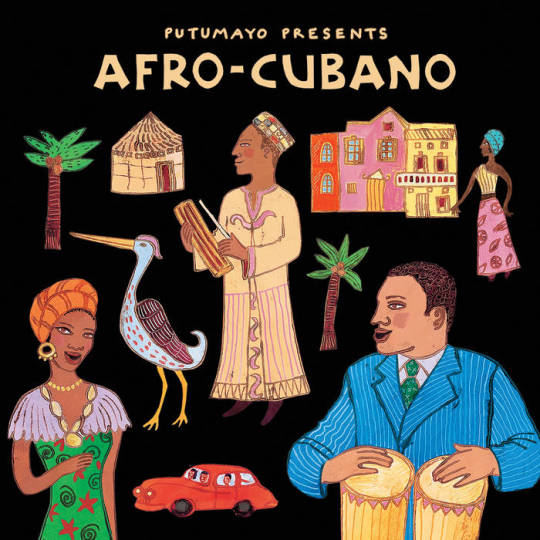
Music of African heritage in Cuba derives from the musical traditions of the many ethnic groups from different parts of West and Central Africa that were brought to Cuba as slaves between the 16th and 19th centuries. Members of some of these groups formed their own ethnic associations or cabildos, in which cultural traditions were conserved, including musical ones. Music of African heritage, along with considerable Iberian (Spanish) musical elements, forms the fulcrum of Cuban music.
Much of this music is associated with traditional African religion – Lucumi, Palo, and others – and preserves the languages formerly used in the African homelands. The music is passed on by oral tradition and is often performed in private gatherings difficult for outsiders to access. Lacking melodic instruments, the music instead features polyrhythmic percussion, voice (call-and-response), and dance. As with other musically renowned New World nations such as the United States, Brazil and Jamaica, Cuban music represents a profound African musical heritage.

Clearly, the origin of African groups in Cuba is due to the island's long history of slavery. Compared to the USA, slavery started in Cuba much earlier and continued for decades afterwards. Cuba was the last country in the Americas to abolish the importation of slaves, and the second last to free the slaves. In 1807 the British Parliament outlawed slavery, and from then on the British Navy acted to intercept Portuguese and Spanish slave ships. By 1860 the trade with Cuba was almost extinguished; the last slave ship to Cuba was in 1873. The abolition of slavery was announced by the Spanish Crown in 1880, and put into effect in 1886. Two years later, Brazil abolished slavery.
Although the exact number of slaves from each African culture will never be known, most came from one of these groups, which are listed in rough order of their cultural impact in Cuba:
The Congolese from the Congo Basin and SW Africa. Many ethnic groups were involved, all called Congos in Cuba. Their religion is called Palo. Probably the most numerous group, with a huge influence on Cuban music.
The Oyó or Yoruba from modern Nigeria, known in Cuba as Lucumí. Their religion is known as Regla de Ocha (roughly, 'the way of the spirits') and its syncretic version is known as Santería. Culturally of great significance.
The Kalabars from the Southeastern part of Nigeria and also in some part of Cameroon, whom were taken from the Bight of Biafra. These sub Igbo and Ijaw groups are known in Cuba as Carabali,and their religious organization as Abakuá. The street name for them in Cuba was Ñáñigos.
The Dahomey, from Benin. They were the Fon, known as Arará in Cuba. The Dahomeys were a powerful group who practised human sacrifice and slavery long before Europeans arrived, and allegedly even more so during the Atlantic slave trade.
Haiti immigrants to Cuba arrived at various times up to the present day. Leaving aside the French, who also came, the Africans from Haiti were a mixture of groups who usually spoke creolized French: and religion was known as vodú.
From part of modern Liberia and Côte d'Ivoire came the Gangá.
Senegambian people (Senegal, the Gambia), but including many brought from Sudan by the Arab slavers, were known by a catch-all word: Mandinga. The famous musical phrase Kikiribu Mandinga! refers to them.
Subsequent organization
The roots of most Afro-Cuban musical forms lie in the cabildos, self-organized social clubs for the African slaves, and separate cabildos for separate cultures. The cabildos were formed mainly from four groups: the Yoruba (the Lucumi in Cuba); the Congolese (Palo in Cuba); Dahomey (the Fon or Arará). Other cultures were undoubtedly present, more even than listed above, but in smaller numbers, and they did not leave such a distinctive presence.
Cabildos preserved African cultural traditions, even after the abolition of slavery in 1886. At the same time, African religions were transmitted from generation to generation throughout Cuba, Haiti, other islands and Brazil. These religions, which had a similar but not identical structure, were known as Lucumi or Regla de Ocha if they derived from the Yoruba, Palo from Central Africa, Vodú from Haiti, and so on. The term Santería was first introduced to account for the way African spirits were joined to Catholic saints, especially by people who were both baptized and initiated, and so were genuine members of both groups. Outsiders picked up the word and have tended to use it somewhat indiscriminately. It has become a kind of catch-all word, rather like salsa in music.
The ñáñigos in Cuba or Carabali in their secret Abakuá societies, were one of the most terrifying groups; even other blacks were afraid of them:
Girl, don't tell me about the ñáñigos! They were bad. The carabali was evil down to his guts. And the ñáñigos from back in the day when I was a chick, weren't like the ones today... they kept their secret, like in Africa.
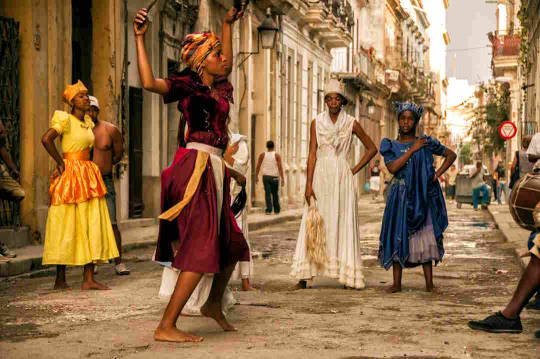
African sacred music in Cuba
All these African cultures had musical traditions, which survive erratically to the present day, not always in detail, but in the general style. The best preserved are the African polytheistic religions, where, in Cuba at least, the instruments, the language, the chants, the dances and their interpretations are quite well preserved. In few or no other American countries are the religious ceremonies conducted in the old language(s) of Africa, as they are at least in Lucumí ceremonies, though of course, back in Africa the language has moved on. What unifies all genuine forms of African music is the unity of polyrhythmic percussion, voice (call-and-response) and dance in well-defined social settings, and the absence of melodic instruments of an Arabic or European kind.
Not until after the Second World War do we find detailed printed descriptions or recordings of African sacred music in Cuba. Inside the cults, music, song, dance and ceremony were (and still are) learnt by heart by means of demonstration, including such ceremonial procedures conducted in an African language. The experiences were private to the initiated, until the work of the ethnologist Fernando Ortíz, who devoted a large part of his life to investigating the influence of African culture in Cuba. The first detailed transcription of percussion, song and chants are to be found in his great works.
There are now many recordings offering a selection of pieces in praise of, or prayers to, the orishas. Much of the ceremonial procedures are still hidden from the eyes of outsiders, though some descriptions in words exist.
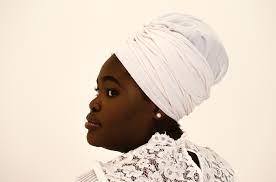
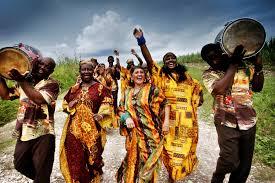
Yoruba and Congolese rituals
Main articles: Yoruba people, Lucumi religion, Kongo people, Palo (religion), and Batá
Religious traditions of African origin have survived in Cuba, and are the basis of ritual music, song and dance quite distinct from the secular music and dance. The religion of Yoruban origin is known as Lucumí or Regla de Ocha; the religion of Congolese origin is known as Palo, as in palos del monte.[11] There are also, in the Oriente region, forms of Haitian ritual together with its own instruments and music.
In Lucumi ceremonies, consecrated batá drums are played at ceremonies, and gourd ensembles called abwe. In the 1950s, a collection of Havana-area batá drummers called Santero helped bring Lucumí styles into mainstream Cuban music, while artists like Mezcla, with the lucumí singer Lázaro Ros, melded the style with other forms, including zouk.
The Congo cabildo uses yuka drums, as well as gallos (a form of song contest), makuta and mani dances. The latter is related to the Brazilian martial dance capoeira
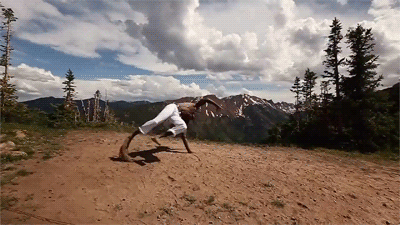
#african#afrakan#kemetic dreams#africans#brownskin#brown skin#afrakans#african culture#fitness#afrakan spirituality#afro cuban music#afro cuban#igbo#yoruba#congo#african music
180 notes
·
View notes
Text
AFRICAN VOODOO
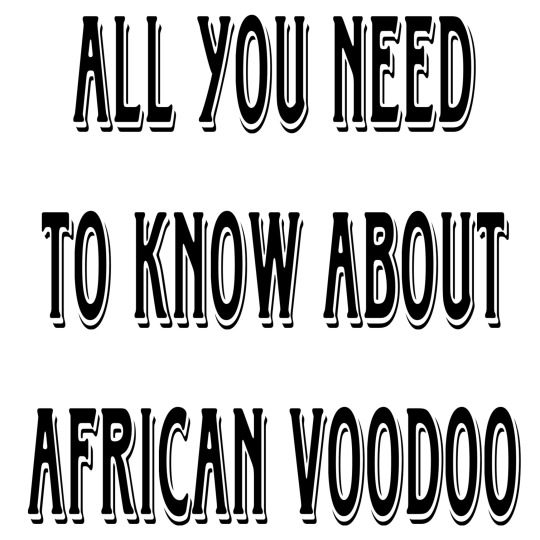
The deep truth about AFRICAN VOODOO
African Voodoo: Unraveling the Mysteries of a Rich Spiritual Tradition
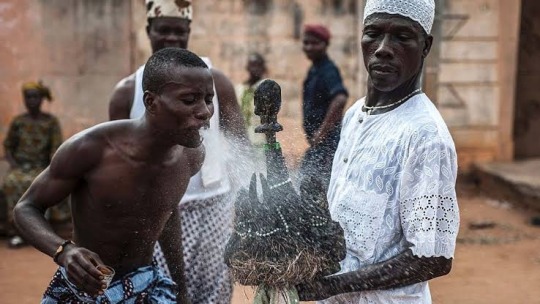
African Voodoo, often shrouded in mystery and misconceptions, is a complex and fascinating spiritual tradition with deep-rooted cultural significance. This ancient belief system, practiced in various forms across the African continent and the African diaspora, offers a unique perspective on the relationship between humans, nature, and the divine. In this article, we will delve into the world of African Voodoo, exploring its history, beliefs, rituals, and its enduring impact on the cultures and societies where it thrives.
A Diverse Tradition
Voodoo, also spelled Vodou or Vodun, is not a monolithic belief system; rather, it is a diverse and adaptable spiritual tradition that has evolved differently in various regions of Africa and beyond. Its origins can be traced back to the indigenous religions of West and Central Africa, where it was practiced by different ethnic groups. Over time, African Voodoo underwent syncretism with Catholicism and indigenous beliefs in the Caribbean, particularly in Haiti, giving birth to Haitian Vodou, which is perhaps the most well-known form of Voodoo.
Core Beliefs
At its core, African Voodoo centers around the veneration of spirits, ancestors, and deities. These spirits are believed to have the power to influence human life and the natural world. Each spirit has a specific domain, and practitioners seek their guidance and assistance through various rituals and offerings. Ancestor worship is a fundamental aspect of Voodoo, as it connects the living to their familial lineage and heritage.
The Loa, or spirits, are a central focus of Voodoo ceremonies. These spirits are intermediaries between humans and the ultimate divine force. Practitioners often enter trance-like states to communicate with the Loa, who possess them temporarily during rituals. The Loa are known for their distinct personalities and preferences, and offerings such as food, drinks, and dance are made to appease and honor them.
Rituals and Practices
Voodoo rituals are colorful and lively events filled with drumming, dancing, singing, and the use of symbolic objects. Rituals are often held in temples or outdoor spaces, and they vary widely depending on the specific tradition and purpose. Some rituals are celebratory, while others are intended to seek protection, healing, or guidance.
One of the most famous Voodoo rituals is the "Voodoo Doll," which is often misunderstood. These dolls are not meant for causing harm but are used as tools for healing or connecting with a specific person's spirit. Pins may be used symbolically to focus intention.
Voodoo in the African Diaspora
The transatlantic slave trade played a significant role in spreading African Voodoo to the Americas, particularly in regions like Haiti, New Orleans, and Brazil. In these places, Voodoo underwent further syncretism with local beliefs and Catholicism, resulting in unique variations of the tradition.
Haitian Vodou, for instance, is a vibrant blend of African Voodoo, Catholicism, and indigenous Taino beliefs. It has had a profound impact on Haitian culture and played a central role in the struggle for independence from colonial rule.
Misconceptions and Stereotypes
African Voodoo has been the subject of many misconceptions and stereotypes, often portrayed negatively in popular culture. These portrayals frequently focus on the more sensational aspects of Voodoo, such as curses and zombies, rather than its rich cultural and spiritual dimensions. It's important to recognize that Voodoo is a legitimate religious practice for millions of people, and like any belief system, it encompasses a wide range of beliefs and practices.
African Voodoo is a complex, multifaceted spiritual tradition with a deep and enduring cultural significance. It is a testament to the resilience of African heritage and the ability of beliefs to adapt and evolve over time. Beyond the stereotypes and misconceptions, Voodoo represents a profound connection between humans, nature, and the divine—a connection that continues to shape the lives and cultures of those who practice it.
Communication with the spirits, often referred to as Loa or Lwa in Voodoo, is a central aspect of Voodoo rituals and practices. Here's an overview of how practitioners communicate with these entities:

1. **Rituals and Offerings**: Voodoo rituals are the primary means of communication with the spirits. Practitioners gather in a designated sacred space, such as a temple or outdoor altar. They often create an elaborate ritual environment with symbols, candles, and ceremonial objects. Offerings, including food, drinks, tobacco, and other items, are presented to specific spirits to gain their favor and attention.
2. **Dance and Music**: Music and dance are essential elements of Voodoo ceremonies. Drumming and chanting create a rhythmic and trance-inducing atmosphere. Through dance and music, practitioners enter altered states of consciousness, allowing them to connect with the spirits more profoundly. It is believed that the spirits may possess individuals during these ceremonies, providing a direct channel for communication.
3. **Possession and Trance**: One of the most distinctive aspects of Voodoo rituals is the concept of spirit possession. Practitioners, often referred to as "servants of the spirits," may enter a trance-like state during which a particular Loa or spirit is believed to take control of their body. In this state, the possessed individual may speak in the voice of the spirit, offering guidance, advice, or requests on behalf of the spirit.
4. **Divination**: Divination is another way to communicate with the spirits in Voodoo. Practitioners may use various divination tools such as tarot cards, cowrie shells, or casting of objects to seek guidance from the spirits. These divination practices help practitioners understand the desires and intentions of the spirits and may provide insights into their own lives.
5. **Prayer and Invocation**: Voodoo practitioners often use prayer and invocation to establish a connection with the spirits. Specific prayers or invocations are recited to call upon a particular spirit's presence and assistance. These prayers are typically passed down through generations and may be spoken in a specific language or dialect.
6. **Voodoo Dolls**: Contrary to popular misconceptions, Voodoo dolls are not used for causing harm but are symbolic tools for communication. They can represent a specific person or spirit and are employed in rituals to convey intentions, requests, or healing energy to the spirits associated with them.
It's important to note that communication with the spirits in Voodoo is a deeply spiritual and cultural practice, and the methods may vary among different Voodoo traditions and communities. Voodoo practitioners believe that these rituals and practices maintain a reciprocal relationship with the spirits, offering offerings and devotion in exchange for protection, guidance, and assistance in various aspects of life.
Masquerades and Voodoo in Africa: A Cultural Tapestry of Spiritual Expression
Africa is a continent rich in cultural diversity, and its spiritual practices are as varied as its landscapes. Among the many vibrant traditions that permeate African culture, masquerades and Voodoo (often spelled Vodun or Vodou) hold significant places in the hearts and lives of its people. This article explores the fascinating intersection of masquerades and Voodoo, shedding light on how these practices are intertwined with African spirituality.
**Masquerades: The Embodiment of Spirits**

Masquerades are a prominent cultural phenomenon across Africa, characterized by elaborate costumes, masks, and dances. These performances serve multifaceted purposes, including entertainment, social commentary, and spiritual expression. However, it's the latter aspect, the spiritual dimension, that ties masquerades to Voodoo and other indigenous African belief systems.
1. **Role of Ancestors**: In many African cultures, masquerades are a means of connecting with ancestors and spirits of the deceased. The masks and costumes worn by performers often represent these spirits. During masquerade ceremonies, participants believe that the spirits inhabit the masks and interact with the living. This interaction serves as a way to honor and seek guidance from the ancestors.
2. **Protection and Cleansing**: Some masquerades have protective roles in communities. They are believed to ward off evil spirits, illnesses, or other malevolent forces. These masquerades often perform purification rituals, symbolically cleansing the community and its members.
3. **Harvest and Fertility Celebrations**: Masquerades are frequently associated with agricultural and fertility rites. They may perform dances and rituals to ensure a bountiful harvest or to promote fertility among the community members.
4. **Social Order and Governance**: Masquerades also play a role in enforcing social norms and maintaining order within communities. They may act as judges, mediators, or enforcers of communal rules during their performances.
**Voodoo: The Spiritual Heartbeat**
Voodoo, a widely practiced religion across West Africa and its diaspora, is deeply entwined with masquerades and the spiritual fabric of the continent.
1. **Ancestor Worship**: Voodoo places a significant emphasis on ancestor worship, much like masquerades. Practitioners believe that the spirits of ancestors are ever-present and can influence the living. Offerings, rituals, and masquerade performances are ways to honor and seek the guidance of these spirits.
2. **Connection to Nature**: Voodoo, like many African belief systems, recognizes the close relationship between humans and nature. It views natural elements, such as rivers, forests, and animals, as inhabited by spirits. Masquerades often incorporate nature-centric symbolism in their performances.
3. **Trance and Possession**: Both Voodoo and certain masquerades involve altered states of consciousness. In Voodoo, devotees may enter trances and become possessed by spirits, similar to the possession experiences during some masquerade ceremonies. These states facilitate direct communication with the divine.
4. **Rituals and Sacrifices**: Offerings and sacrifices are common in both Voodoo and masquerade traditions. These rituals are believed to appease spirits and seek their favor.
**Cultural Resilience and Transformation**
While masquerades and Voodoo have endured the test of time and colonization, they have also adapted and evolved. In the African diaspora, especially in the Americas, they fused with other cultural elements and religions, giving rise to unique traditions such as Haitian Vodou and New Orleans Voodoo.
masquerades and Voodoo in Africa are vibrant expressions of spirituality, culture, and identity. They are living traditions that continue to shape the lives and beliefs of countless individuals and communities, offering insights into the enduring resilience and adaptability of African cultures in the face of change and adversity.
The timing for Voodoo practices, like many spiritual traditions, can vary depending on the specific tradition, the purpose of the practice, and the preferences of the practitioner. There is no universally "best" time for Voodoo practice, but certain times and occasions are commonly observed:
1. **Festival Days**: Many Voodoo traditions have specific festival days or holidays when practitioners gather to perform rituals and ceremonies. For example, in Haitian Vodou, the Festival of the Ancestors (Fèt Gede) is a significant event where people honor and communicate with their ancestors. These festivals often have fixed dates in the Voodoo calendar.
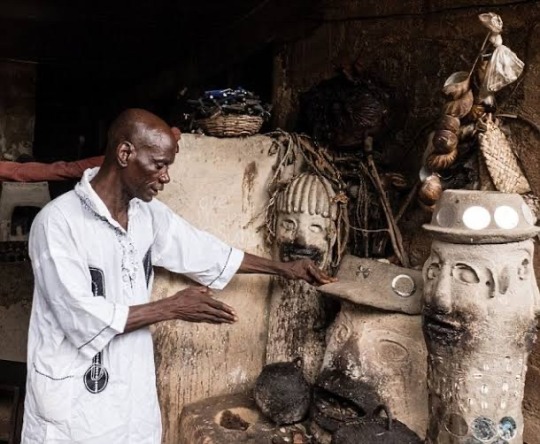
2. **Full Moon and New Moon**: Lunar phases are significant in various spiritual practices, including Voodoo. Some practitioners prefer to conduct rituals during the full moon or new moon, believing that these phases are particularly potent for spiritual work. The full moon is often associated with amplifying energy and intentions, while the new moon is seen as a time for new beginnings.
3. **Nighttime**: Many Voodoo rituals take place during the nighttime. This is believed to be a time when the veil between the spiritual and physical realms is thinner, making it easier to communicate with the spirits. Candlelit ceremonies, drumming, and dancing are common elements of Voodoo rituals conducted at night.
4. **Personal Preference**: Individual practitioners may have their own preferred times for Voodoo practice based on their personal experiences and beliefs. Some may feel a stronger connection to the spirits during specific times of the day or year.
5. **Life Events**: Voodoo is often integrated into various life events such as births, marriages, and funerals. The timing of these rituals is determined by the occurrence of these events.
6. **Consulting a Voodoo Priest/Priestess**: For more specific guidance on the timing of Voodoo practices, consulting a Voodoo priest or priestess is advisable. They can provide insights based on their knowledge and experience within their particular Voodoo tradition.
It's essential to remember that Voodoo is not a monolithic practice; it encompasses various traditions and regional variations, each with its own customs and beliefs. Therefore, the best time for Voodoo practice can differ significantly from one tradition to another. Additionally, Voodoo is deeply rooted in cultural and spiritual contexts, so practitioners often follow the customs passed down through generations within their specific communities.
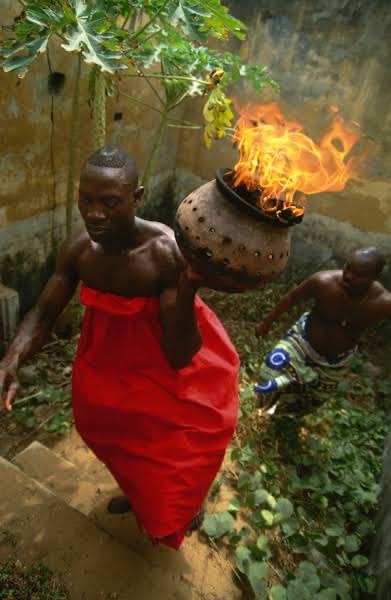
#life#animals#culture#aesthetic#black history#history#blm blacklivesmatter#anime and manga#architecture#black community#heritagesites#culturaltours
266 notes
·
View notes
Text
August 24, 2024
HEATHER COX RICHARDSON
AUG 25
The raucous roll call of states at the 2024 Democratic National Convention on Tuesday, as everybody danced to DJ Cassidy’s state-themed music, Lil Jon strode down the aisle to cheers for Georgia, and different delegations boasted about their states and good-naturedly teased other delegations, brought home the real-life meaning of E Pluribus Unum, “out of many, one.” From then until Thursday, as a sea of American flags waved and attendees joyfully chanted “USA, USA, USA,” the convention welcomed a new vision for the Democratic Party, deeply rooted in the best of traditional America.
Under the direction of President Joe Biden, over the past three and a half years the Democrats have returned to the economic ideology of the New Deal coalition of the 1930s. This week’s convention showed that it has now gone further, recentering the vision of government that President Franklin Delano Roosevelt’s secretary of labor, Frances Perkins, called upon to make it serve the interests of communities.
When the Biden-Harris administration took office in 2021, the United States was facing a deadly pandemic and the economic crash it had caused. The country also had to deal with the aftermath of the attempt of former president Donald Trump to overthrow the results of the 2020 presidential election and seize the presidency. It appeared that many people in the United States, as in many other countries around the world, had given up on democracy.
Biden set out to prove that democracy could work for ordinary people by ditching the neoliberalism that had been in place for forty years. That system, begun in the 1980s, called for the government to allow unfettered markets to organize the economy. Neoliberalism’s proponents promised it would create widespread prosperity, but instead, it transferred more than $50 trillion from the bottom 90% of Americans to the top 1%. As the middle class hollowed out, those slipping behind lined up behind an authoritarian figure who promised to restore their former centrality by attacking those he told them were their enemies.
When he took office, Biden vowed to prove that democracy worked. With laws like the American Rescue Plan, the Bipartisan Infrastructure Act, the CHIPS and Science Act, and the Inflation Reduction Act, the Democrats directed investment toward ordinary Americans. The dramatic success of their economic program proved that it worked. On Wednesday, former president Bill Clinton noted that since 1989, the U.S. has created 51 million new jobs. Fifty million of those jobs were created under Democratic presidents, while only 1 million were added under Republicans—a striking statistic that perhaps will put neoliberalism, or at least the tired trope that Democrats are worse for the economy than Republicans, to bed.
Vice President Kamala Harris’s nomination convention suggested a more thorough reworking of the federal government, one that also recalls the 1930s but suggests a transformation that goes beyond markets and jobs.
Before Labor Secretary Perkins’s 1935 Social Security Act, the government served largely to manage the economic relationships between labor, capital, and resources. But Perkins recognized that the purpose of government was not to protect property; it was to protect the community. She recognized that children, women, and elderly and disabled Americans were as valuable to the community as young male workers and the wealthy men who employed them.
With a law that established a federal system of old-age benefits; unemployment insurance; aid to homeless, dependent, and neglected children; funds to promote maternal and child welfare; and public health services, Perkins began the process of molding the government to reflect that truth.
Perkins’s understanding of the United States as a community reflected both her time in a small town in Maine and in her experience as a social worker in inner-city Philadelphia and Chicago before the law provided any protections for the workers, including children, who made the new factories profitable. She understood that while lawmakers focused on male workers, the American economy was, and always has been, utterly dependent on the unrecognized contributions of women and marginalized people in the form of childcare, sharing food and housing, and the many forms of unpaid work that keep communities functioning.
This reworking of the American government to reflect community rather than economic
relationships changed the entire fabric of the country, and opponents have worked to destroy it ever since FDR began to put it in place.
Now, in their quest to win the 2024 election, Vice President Kamala Harris and Minnesota governor Tim Walz—the Democratic nominees for president and vice president—have reclaimed the idea of community, with its understanding that everyone matters and the government must serve everyone, as the center of American life.
Their vision rejects the division of the country into “us” and “them” that has been a staple of Republican politics since President Richard M. Nixon. It also rejects the politics of identity that has become identified with the argument that the United States has been irredeemably warped by racism and sexism. Instead, at the DNC, Democrats acknowledged the many ways in which the country has come up short of its principles in the past, and demanded that Americans do something to put in place a government that will address those inequities and make the American dream accessible to all.
Walz personifies this community vision. On Wednesday he laid it out from the very beginning of his acceptance speech, noting that he grew up in Butte, Nebraska, a town of 400 people, with 24 kids in his high school class. “[G]rowing up in a small town like that,” he said, “you'll learn how to take care of each other that that family down the road, they may not think like you do, they may not pray like you do, they may not love like you do, but they're your neighbors and you look out for them and they look out for you. Everybody belongs and everybody has a responsibility to contribute.” The football players Walz coached to a state championship joined him on stage.
Harris also called out this idea of community when she declined to mention that, if elected, she will be the first female president, and instead remembered growing up in “a beautiful working-class neighborhood of firefighters, nurses, and construction workers, all who tended their lawns with pride.” Her mother, Harris said, “leaned on a trusted circle to help raise us. Mrs. Shelton, who ran the daycare below us and became a second mother. Uncle Sherman. Aunt Mary. Uncle Freddy. And Auntie Chris. None of them, family by blood. And all of them, Family. By love…. Family who…instilled in us the values they personified. Community. Faith. And the importance of treating others as you would want to be treated. With kindness. Respect. And compassion.”
The speakers at the DNC called out the women who make communities function. Speaker after speaker at the DNC thanked their mother. Former first lady Michelle Obama explicitly described her mother, Marian Robinson, as someone who lived out the idea of hope for a better future, working for children and the community. Mrs. Obama described her mother as “glad to do the thankless, unglamorous work that for generations has strengthened the fabric of this nation.”
Mrs. Obama, Harris, and Walz have emphasized that while they come from different backgrounds, they come from what Mrs. Obama called “the same foundational values”: “the promise of this country,” “the obligation to lift others up,” a “responsibility to give more than we take.” Harris agreed, saying her mother “taught us to never complain about injustice. But…do something about it. She also taught us—Never do anything half-assed. That’s a direct quote.”
The Democrats worked to make it clear that their vision is not just the Democratic Party’s vision but an American one. They welcomed the union workers and veterans who have in the past gravitated toward Republicans, showing a powerful video contrasting Trump’s photo-ops, in which actors play union workers, with the actual plants being built thanks to money from the Biden-Harris administration. The many Democratic lawmakers who have served in the military stood on stage to back Arizona representative Ruben Gallego, a former Marine, who told the crowd that the veteran unemployment rate under Biden and Harris is the lowest in history.
The many Republicans who spoke at the convention reinforced that the Democratic vision speaks for the whole country. Former representative Adam Kinzinger (R-IL) identified this vision as “conservative.” “As a conservative and a veteran,” he said “I believe true strength lies in defending the vulnerable. It’s in protecting your family. It’s in standing up for our Constitution and our democracy. That…is the soul of being a conservative. It used to be the soul of being a Republican,” Kinzinger said. “But Donald Trump has suffocated the soul of the Republican Party.”
“[A] harm against any one of us is a harm against all of us,” Harris said. And she reminded people of her career as a prosecutor, in which “[e]very day in the courtroom, I stood proudly before a judge and said five words: ‘Kamala Harris, for the People.’ My entire career, I have only had one client. The People.”
“And so, on behalf of The People. On behalf of every American. Regardless of party. Race. Gender. Or the language your grandmother speaks. On behalf of my mother and everyone who has ever set out on their own unlikely journey. On behalf of Americans like the people I grew up with. People who work hard. Chase their dreams. And look out for one another. On behalf of everyone whose story could only be written in the greatest nation on Earth. I accept your nomination for President of the United States of America.”
The 100,000 biodegradable balloons that fell from the rafters when Vice President Harris accepted the Democratic nomination for president were blown up and tied by a team of 55 balloon artists from 18 states and Canada who volunteered to prepare the drop in honor of their colleague, Tommy DeLorenzo, who, along with his husband Scott, runs a balloon business. DeLorenzo is battling cancer. “We’re more colleagues than competitors,” Patty Sorell told Sydney Page of the Washington Post. “We all wanted to do something to help Tommy, to show him how much we love him.”
“Words cannot express the gratitude I feel for this community,” DeLorenzo said.

38 notes
·
View notes
Text
Diner Journalism

Tom the Dancing Bug – Chagrin Falls: "Diner Journalism"
TOM the DanciNg Bug
Chagrin Falls "DINER JOURNALISM"
by RUBEN BOLLING
==
Panel 1: a sign outside a diner
CENTRAL DINER
WELCOME BACK ELITIST COASTAL REPORTERS
==
Panel 2: a reporter talking to a waitress
Waitress: Hey, Bill. It's been a while! What's your angle, hon?
Reporter: Trump's enduring popularity with salt-of-the-Earth real Americans.
Waitress: You'll want Roger and Abby over in booth 4.
Roger (in a red cap): Over here!
==
Panel 3: A reporter calling out to men in red caps in booths
Reporter: Anybody here a real American farm owner with a severe labor shortage who doesn't know that Trump opposes immigration?
Man in red cap: Me! Have a seat!
==
Panel 4: A reporter and a cameraman at a booth with a woman (Sandra) eating a hamburger
Reporter: Hi, Sandra. Just sit here while I tape my intro...
Sandra: Alright.
Reporter: "Here in America's real heartland, very real Americans have not wavered in their support of Donald Trump."
==
Panel 5: The reporter from panel 4 continues to speak, while a woman reporter holding a notebook calls out to men in booths wearing red caps
Panel 4 reporter: Outside the ivory-tower confines of the coastal bubble where not-real Americans live, the prosecutions of Trump are seen as...
Woman reporter: I'm on deadline! Anyone here a charismatic White Supremacist?
Man in booth: Yo!
==
Panel 6: Reporter with a laptop at a booth with a woman drinking coffee
Reporter: Maybe with less racism, tell me again why you support Trump.
Woman: Well, when he talks about non-Whites, he really tells it like it is.
Reporter: Mmm... A little less.
==
Panel 7: Angry man in MAGA cap at booth talking to rapt reporter
Man: Yes, I'd like to punch you in your lamestream vermin face.
Reporter: Fascinating! What are your views on Bud Light? On the price of eggs? Tell me *every*thing!
==
Panel 8: Couple talking to reporter while new man enters diner and speaks to Beth, the waitress
Man from couple: Everyone at January 6 was an FBI agent!
Woman from couple: And everyone was a freedom-fighting patriot!
Reporter: Got it. Both.
Man talking to Beth: Table for one.
==
Panel 9: Man who entered restaurant turns to leave while Beth the waitress talks with him
Beth: Are you coastal media elite or heartland real American interview subject, hon?
Speech bubble from out-of-panel: "Then Jack slams his real American fist into my effete, overeducated jaw!"
SFX: POW!
Man leaving diner: Never mind. I'll eat at home.
==
The End
134 notes
·
View notes
Text





Olive Craddock, Anglo-Indian dancer trained in British Colonial India, who performed under the moniker Roshanara. Known for showcasing central Indian dance techniques in America and Britain.
56 notes
·
View notes
Text
Monkey Man and why I loved the heck out of it

At it's core, it's a Bollywood flick presented to the West with familiar nods to previous action films - I definitely picked up hints of Tony Jaa's influence on Asian action flicks throughout.
It's heavily focused on police corruption, something commented a lot about in India, and here, more importantly, Indian films. Just like America has its love affair with mobster flicks, Bollywood has a long history featuring films that showcase police corruption, sometimes tied into political extremism, fanatical or greedy religious leaders, and Monkey Man comments on all this as well and pays nods to that commonality. We've got televangelists and religious leaders in the states funnelling money, preaching prosperity gospel, and using it to influence politics and fund lavish lifestyles here.
Monkey Man shows this happening in India, and is filled with Indian culture and symbolism through out. The focus on Hanuman, the god and one worshiped by the strong, chaste, wrestlers, champions, and fighters. It's a common thing to have a household deity if you will. Some families might choose to focus worship on Ganesh, others Hanuman, some might do Mata Rani or Lakshmi. Here, it's the divine Vanara (monkey people race) - one of the Chiranjivi - immortals/forever-lived.
Hanuman. Themes of rebirth, common in South Asian history and mythology are present from Kid being a ringer, beat up fighter getting whooped for money to being reborn and facing his trauma through a ritual/meditate process that I don't want to get too much into to not spoil the movie. Post that, he begins his own self alchemy to really become the true Monkey Man. Nods to Ramayama, and an unapologetically Indian story featuring dialogues throughout in Hindi - don't worry, there are subtitles.
And of course a love for action flicks before it, all the way back to Bruce Lee. A beautiful use tbh of an autorickshaw (and you might know them as tuk-tuks in Thailand) which are popular in India with an added kick...I swear, that thing had to be modified with a hayabusa motor. Which is an actual thing people do - modding those dinky rickshaws with motorcycle engines, and considering they weigh nothing at all, they can REALLY FLY once you do that.
Monkey Man brings to the big screen other elements of India people might not know about, such as the gender non conforming and trans community that has a long history in India, presenting them as action stars as they go up against a system of corrupt elites oppressing part of the city, marginalized communities, and minority voices as depicted in the film. I'm not sure if people are going to get all of that without having the context, but I love that it does it without holding anyone's hands.
It's a fun action flick to see in the age of superhero films, and I say that as an obvious superhero/sff nerd. Also loved that Dev included a little bit about Hanuman's own story in the film, and the loss of his powers - almost mirrored by Kid's own loss of self/skills, strength until he confronts his trauma and is reborn, and in fact, remade (not necessarily the same). Also, the use of music was brilliant, including one scene with a tabla (the paired hand drums of south asia) - and Indian music is central to Indian stories.
This is a culture with evidence going back to the Paleolithic with cave murals showing art of Indian dance nearly 30,000 years ago. Yeah, that far back. As well as Mesolithic period art depicting musical instruments such as gongs, lyres, and more.
Indian music is some of the earliest we can find that has high developed beat and rhythm structures such as 5, 7, 9 and now the extremely common and known 4/4 and 3/4 - which so much of Western music is built upon. The foundations and experimentation of/in Jazz. John Coltrane and John Cage were heavily inspired by Indian music and incorporated a lot from it into their works. And Monkey Man blends Eastern and Western music through the narrative as comfortably as it does an Indian story in a very familiar Western accessible structure.
Dev did a wonderful job. And thanks to Jordan Peele for bringing it to screens.
#monkey man#jordan peele#dev patel#Bollywood#bollywood movies#Indian films#indian culture#India#hanuman#ganesh#south asian#Ramayama#superhero#superhero films#Indian music#bollywood songs#loved this film#great film#love this movie#john coltrane#John Cage#Jazz#music soundtrack#films#movies#movie review
56 notes
·
View notes
Text
The Hound of the Baskervilles: The Problem
Yew hedges are pruned lots of European yew (Taxus baccata), a highly dense tree that can cope with heat, cold and pollution.
A wicket gate is a small narrow door built into a fence, wall or larger gate. You would often find them in city gates as they could be opened to admit pedestrians without incurring the time and security risk of opening the main gate.
Padlocks have been around since ancient civilisation, but the Industrial Revolution made them much easier to make and available to the masses.
Clogs were very popular in Britain at this point as they were cheap, strong footwear for industrial and agricultural workers. People danced in them and it is still a thing in Wales. One British expression for dying is "popped his clogs".
Waterloo was the main railway arrival point in London for ocean liner passengers disembarking at Southampton (a major port of arrival for them), with special trains being put on to meet the various liners. An express train in 1888 could do the journey from the Southampton Docks station in 2 hours and 10 minutes. The electrification of the line from London to Southampton by British Rail led to the closure of this station and nearby Northam in 1966 to passengers, freight services running a year longer. Passenger services were diverted to Southampton Central. The station's platform area is now a car park under the old glass canopy and the station building is now a casino, part of the Gentings Casino chain.
Yellow fever is a viral disease spread by mosquitoes. Most people get over it in five days or so, but 15% will get a second phase including jaundice (hence the name) with a 20%-50% fatality rate at that point. Africans were mistakenly thought to be immune to this when they had in fact merely acquired immunity via burying their dead close to their habitations with resultant mild cases among children. When these traditions were stopped by imperalists, they got it just as bad as everyone else. It is thought it came to South and Central America via the Spanish conquerors.
A successful, easily manufacturable vaccine was developed in 1937. A lot of countries now require some form of yellow fever vaccination, although precise regulations vary.
Shag tobacco is fine-cut tobacco used for self-made cigarettes i.e. roll-ups.
The Ordnance here refers to the Ordnance Survey, which I have discussed in the past.
Princetown prison is HMP Dartmoor, originally opened in 1809 for prisoners of war from the Napoleonic Wars and then the War of 1812. Closed in 1815, it was rebuilt in 1850-1851 to become a civilian prison; today it is a Category C (general population) men's prison.
27 notes
·
View notes
Text
𝚅𝚊𝚕𝚎𝚛𝚒𝚎 𝙻𝚒𝚝𝚝𝚕𝚎𝚋𝚒𝚛𝚍 || 𝚆𝙺 𝚘𝚌
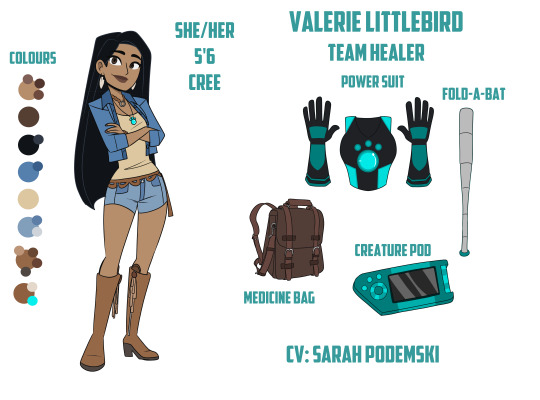
•───────•°•❀•°•───────•
Name: Valerie Littlebird
Also known as: Val, Chickadee (Martin), Kiwi(Gourmand), Dr. Lady(Zach)
Age: 25
Ethnicity: Cree
Gender: Female(She/Her)
Birthday: April 29th(Taurus)
Occupation: Medic for Tortuga HQ, Herbalist for Tortuga HQ
Height: 5'6(168 cm)
CV: Sarah Podemski
Signature Colour: Teal
Personality:
Valerie is known for her quiet, stoic and reserved nature. She usually keeps to herself, but she is not averse to joining in on the fun. Her level-headed and strategic thinking is particularly valuable during missions, especially when things get stressful. Valerie is a great listener, and her unwavering self-confidence makes her one of the most hardworking members of the team. She is very practical in her approach to problem-solving and is highly attuned to the world around her. Valerie has a very strong moral compass, and she holds her beliefs very strongly, to the point where she can be petty about them.
Despite being kind-hearted, Valerie can sometimes be overly analytical and judgmental. She has a strong aversion to dishonesty, believing that lying is a cheat to life, and this can visibly upset her. She can also be dismissive of emotions and tends to avoid discussing them unless she initiates the conversation. Valerie has a strong need for personal space and dislikes physical contact unless she initiates it herself.
Abilities:
Valerie is an incredibly skilled individual when it comes to medicine and first aid. Her skills extend to both animals and people and she is often seen tending to her crewmates' injuries, ensuring they are well taken care of. Valerie's expertise in herbs, flowers, and various other plants led her to take on the role of the team's botanist. As a medic, she can make medicine from plants and herbs she grows, making her an essential member of the team. Her proficiency in cooking also means that she can whip up a delicious meal for the crew to enjoy after a long day of adventuring. Valerie is an expert problem solver, and her ability to think outside of the box has often led her to come up with creative solutions to complex problems. Valerie is also fluent in Algonquian, French, and English.
Likes:
Gardening
Botany
Dancing
Ferrets
Birds(Ravens in particular)
Crafting Jewelry
Horses
Personal space
Platypuses
Squirrels
Rain
Dislikes:
Zach
Zachbots
Donita Donata
Dabio
Paisley
Rex
Gourmand
Thunderstorms
Dishonesty
Spiders
Mosquitoes
Ignorance
Loud Noises
Trivia:
Valerie gets the nickname ‘Chickadee’ because of her Chickadee feather earrings.
Ironically enough, her colour scheme is reminiscent of a Bluebird,
Her last name is also ‘Littlebird’.
Valerie makes her jewellery and likes to braid for people when she’s stressed or someone needs to be de-stressed.
Valerie’s medicine bag contains foldable medicine equipment, such as a scalpel, bandages and even several syringes and blood testers.
Valerie has been shown using her Creature Power Suit, but she prefers to use her ‘fold-a-bat’ as a weapon.
Valerie is the only girl in her immediate family - being raised by her two fathers and several older brothers.
Her favourite continent is Central America.
Despite her CPS, Tail Attachment and Creature Pod being teal, her favourite colour is blue.
She is pansexual.
She has a surprisingly good relationship with Donita.
She has never once had a bad hair day.
Her favourite Greek Goddess is Athena.
•───────•°•❀•°•───────•
Hey guys! Sorry, for the unannounced break, Uni started for me and it is a LOT. During this, I started thinking about various ways to improve Willow's design to make a sort of 'final boss' if you will. Thus, Valerie was born! I love her design and just her in general. Let me know what y'all think!
Yes, she is still paired with Martin so expect cute art of them soon.
78 notes
·
View notes
Note
Hi can u please write headcanons for the cullen clan with a witch fem reader likw their reaction to them finding out that u have powers like wanda maximoff from the marvel
Can this be longer then usual please i love ur sm its unbelievable❤❤❤❤
aw thank you nonny, i can't do individual character gifs or else my elderly macbook will combust

Cullens Reacting to Fem!Scarlet-Witch!Reader
Carlisle Cullen
He had his suspicions that you weren't a standard human, but he could never quite put his finger on why he got that vibe from you.
You were admitted to the tiny Forks hospital emergency room after you'd fainted in the street. And for what should've been a very regular medical check, strange things seemed to be happening.
The lights and electronic heart monitor flicked on and off without warning, pens and papers on his desk seemed to move when he turned his back. Waves of red light danced just beyond his sight.
For what his centuries of medical practice told him, you'd be fine, only suffering a slight headache. But the moment you left the room everything appeared to function perfectly again.
Carlisle grew up in a society that endlessly feared the power of witches casting curses and plagues on the people, and he found himself unable to forget what he was taught after he met you.
Carlisle was a man of science, but after living for so long, nothing could explain what had happened with you that day without magic.
Esme Cullen
Esme first meets you at a charity event to raise funds to support overseas humanitarian crises, one of the many charities Esme heads in her free time.
She's busy organising baked goods at a long central table when you walk in, shuffling your feet and glancing around nervously. Seeing your discomfort, Esme goes up to you immediately, asking if you're alright and if she can get you anything.
You insist that you're fine but want to dedicate some time to help support the charity. Esme is delighted to have some more help and asks why this particular charity's cause spoke to you.
You mention that you came from a now collapsed Eastern European state and that you'd come to America to seek safety and justice for everything that happened to you and your people under that corrupt government. That you want to support groups that seek to protect people who are at the mercy of callous and greedy leaders.
Esme is incredibly moved by your story and your values and goes to fetch the paperwork for you to become a volunteer. But then she remembers something that came through the Vampire intelligence network a while ago. The country you came from had been experimenting on its people, giving them abilities that would make them more powerful than vampires.
She stops to consider that maybe you were one of the people they experimented on and that you might have powers that could surpass all vampires. She chases that thought from her mind, for now, reminding herself that she's in no position to be interrogating you if that was the case.
Edward Cullen
At first, Edward was none the wiser of you or your abilities. You were just another girl at Forks High. But slowly, as the days went by, he didn't so much as notice you but instead noticed your influence.
On your first day of school, he stood behind you at the lunch line. The two guys in front of you kept thinking about how excited they were to be getting the last slices of pizza. Suddenly their minds abandon pizza so when they go to order they get the salad option instead.
You drop your hand to your side and get the second-to-last slice, turning to Edward and giving him a knowing wink. Despite the panic gripping his dead heart, Edward shuffles up the counter after you and orders the last pizza slice to keep up appearances.
For the next period, Edward is consumed with thoughts of 'Can she read minds?'. If you could read his mind, you hid it well by ignoring all the panicked thinking he was directing at you. 'Perhaps she's tormenting you on purpose. Can YOU read my mind?', he asks again.
Again you give no indication that you can hear his thoughts. Suddenly, the teacher calls his name, expecting an answer to a question Edward did not hear. Then a soft, ghostly voice reverbs in his head 'The answer is 42'. It was a voice that sounded exactly like you.
Edward awkwardly mutters the answer before the teacher rewards him for being correct. He turns to look at you on the opposite side of the class. So you couldn't read minds then, but could still project your thoughts onto others? Very interesting, very interesting indeed.
Alice Cullen
She recognised you immediately the moment she saw you arrive at Forks High. You had been the one she'd had visions of for months on end.
But you looked different from her visions. Your face was not strained as you contorted a swirling red mist in your hands. Your eyes did not glow red as the tips of your fingers turned black as if dipped in ink.
No instead you seemed almost painfully ordinary as you scrawled long division calculations into your notebook during class.
Alice wondered how to discuss you with her family, from what she saw, you had the power to bend Forks, if not the wider Washington area to your will alone.
Maybe it was best to leave you alone, keep you away from the hidden madness of vampire clans and werewolf treaties. The Volturi would certainly not rest until you were a vampire under their thumb.
Alice decides that if you're as smart as you are powerful, then you'll quickly work everything out for yourself and whether or not you really want to be involved will be up to you.
Emmett Cullen
He genuinely had no idea you existed, you kind of merged into the background with all the other kids at Forks High. That was until the egg incident.
To this day, neither you nor Emmett has spoken about what happened, and he firmly believes that was for the best. But now there is a permanent tension between the two of you, you both know about the other, but you're both unwilling to admit any of it.
It happened on a late October evening, and Emmett was launching eggs into the side of the school building with all his vampiric strength. After all, no one was around to see it, so why would it matter?
Another egg practically evaporated as it hit the brick, splattering into thousands of tiny yoke fragments flying in every direction. It so happened that you had just stepped out of the gymnasium, with egg bits flying toward you at supersonic speeds.
But before the shattered egg could coat your hair, a red barrier of mist emerged from your outstretched hand, deflecting the remnants of egg to land either side of you.
That's when you notice Emmett and Emmett notices you. You both stare at each other, frozen in time. At some point in your impromptu staring contest, you and Emmett silently agree that neither of you would ever talk about what happened and what you were, Emmett certainly wasn't in a position to be throwing eggs in a glass house.
Jasper Hale
When Jasper was mortal, his mother always used to tell him and his sisters scary stories of evil witches who would snatch them in the night if they ever went out wandering.
Jasper never really paid those stories any mind, until he met Maria, and suddenly he began to understand why powerful women should be feared.
You didn't strike him as the 'witchy' kind, no black cats, no large pointy hat, no flying broomsticks, no bubbling cauldron. But just like Maria, you had this aura of some kind, and you certainly weren't no vampire.
He'll admit that he never saw you do anything particularly magical either. But he did notice that people can get scared out of their wits when you're about.
At the same time, there seemed to be this sadness in your eyes, and an exhaustion that didn't truly belong on anybody as young as you.
Jasper goes against all his instincts and begins to investigate you. Over time, he makes you feel more and more relaxed in his presence, maybe you'll let something slip.
Rosalie Hale
Rosalie was used to having people look at her, even in her mortal life, very few could tear their gaze away from her. But today was the day she made eye contact with you as you looked at her.
There was this indescribable energy in your gaze, almost a power. For the first time in her immortal life, Rosalie felt nervous by looking at a human.
As you retreat your eyes and continue onto class, Rosalie realises that she'd stopped pretending to breathe, artificially filling her cold lungs with air once more.
Despite her best interest, Rosalie couldn't get you out of her mind, She found herself following you, watching you in class, seeing where you sat during lunch. And the longer she looked, the more tangible this aura of raw power you had seemed to be.
It was like this shift in the air, the room, the people around you. Apart from this, there was nothing about you that wasn't completely ordinary.
She'll admit you were pretty, not as pretty as her, but then no one really was. For now, she'll keep on watching you, perhaps you'll slip up and reveal what you really are.
#twilight saga imagine#twilight saga x reader#twilight saga headcanons#twilight imagine#twilight headcanons#twilight x reader#twilight reader insert#carlisle cullen#esme cullen#edward cullen#alice cullen#emmett cullen#jasper hale#rosalie hale#qdbs writing#twilight renessaince
730 notes
·
View notes